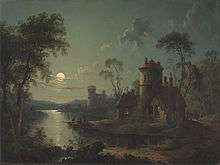Sebastian Pether
Sebastian Pether (1790–1844) was an English landscape-painter.
Life
The eldest son of Abraham Pether, he was a pupil of his father, and followed him in subject matter, but led a beleaguered life. Pether married young and had a large family of nine children, and had few opportunities to create commissioned works and his works were not often exhibited, forcing him to work for dealers to maintain a living.[1] He was well-educated, and even claimed to have first proposed the idea of a stomach-pump to the surgeon Andrew Jukes.[1] During the last years of his life he lost three children to consumption and another to lockjaw; his eldest son William became a mosaic artist.[1] Pether died at Battersea of an inflammatory attack on 14 March 1844 at York Cottage, Battersea Fields, and a subscription was raised for his family.[2] Charity was raised for his surviving daughter in a November 1876 issue of the London Times, who was said to be destitute after ruining her eyesight working as a needlewoman.[3]
Works

Pether's main works consisted in firelights, moonlights and sunsets.[1] In 1814 Pether sent to the Royal Academy View from Chelsea Bridge of the Destruction of Drury Lane Theatre, and in 1826 A Caravan overtaken by a Whirlwind, a commission from John Fleming Leicester, who was his only patron.[1] In the spring of 1842, three pictures which, with the help of a frame-maker, he sent to the Royal Academy, were rejected.[2]
Notes
- Urban, Sylvanus, ed. (1844). "Obituary: Sebastian Pether". The Gentleman's Magazine. XXII. London: John Bowyer Nichols and Son. p. 99.
- Lee, Sidney, ed. (1896). . Dictionary of National Biography. 45. London: Smith, Elder & Co.
- Murdoch, Lydia (16 February 2006). Imagined Orphans: Poor Families, Child Welfare, and Contested Citizenship in London. Rutgers University Press. p. 105. ISBN 9780813541020.
- Attribution
![]()